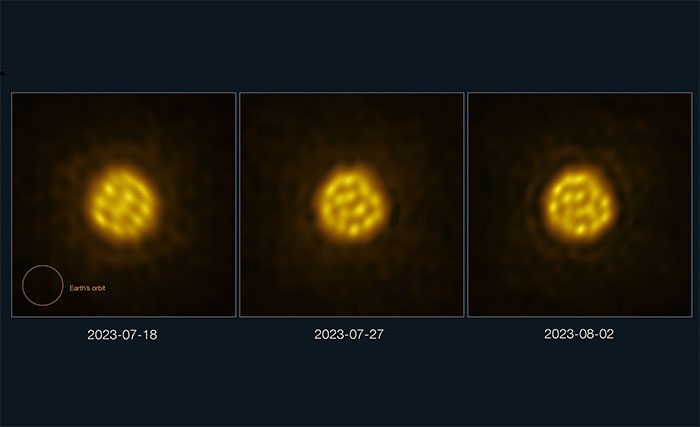R Doradus, an object visible to the naked eye from Earth, is generating gas bubbles 75 times larger than the Sun.
According to Sci-News, this astounding object that scientists have recently observed closely could provide insights into the future of our own Solar System, as the Sun transforms into a red giant star and engulfs the Earth.
R Doradus (HD 29712) is located 178 light-years away from us and belongs to the constellation Dorado.
It is a variable star, with its apparent magnitude frequently fluctuating, and it often appears at levels visible to the naked eye from Earth.

Images of R Doradus over different time periods showing its changes – (Image: ALMA).
In the magnified images captured by the powerful ALMA observation system, R Doradus has “revealed itself” as a bubbling monster.
According to a research team led by Professor Wouter Vlemmings from Chalmers University of Technology in Sweden, the hot gas bubbles generated by R Doradus while bubbling have a diameter 75 times that of the Sun.
Meanwhile, the current diameter of the entire star is 350 times that of the Sun.
However, when it comes to mass, R Doradus is only equivalent to the Sun, indicating that it was once a star similar to our own but has swollen as it transformed into a giant star.
Red giants represent a “dying” phase of a star, when it is nearing the end of its energy supply and becomes superluminous one last time before collapsing into a small white dwarf.
Since they share the same mass, it is possible that R Doradus serves as a perfect representation of what our Sun will look like in 5 billion years, which is the estimated time it will run out of energy.
At that time, the Sun will also expand and engulf the three closest planets: Mercury, Venus, and Earth.
Explaining the gigantic bubbles formed by the boiling R Doradus, Professor Vlemmings noted that the energy in the star’s core – produced by nuclear fusion reactions – can be transported to the star’s surface in the form of large, hot gas bubbles, which then cool and sink.
This mixing motion, known as convection, distributes heavy elements formed in the core, such as carbon and nitrogen, throughout the star.
It is also believed that this process generates stellar winds carrying these elements out into the universe, thereby creating new stars and planets.


















































